50/51 and 50/51N relays
Overcurrent relays are the most commonly-used protective relay type. Time-overcurrent relays are available with various timing characteristics to coordinate with other protective devices and to protect specific equipment. Instantaneous overcurrent relays have no inherent time delay and are used for fast short-circuit protection.

Figure 1 below shows the timing characteristics of several typical 51 time-overcurrent relay curve types, along with the 50 instantaneous characteristic.

The pickup level is set by the tap setting, which is usually set in CT secondary amperes but may be set in primary amperes on some microprocessor-based relays.
In Figure 1, the time dial settings are different to give enough space between the curves to show their differences.
The above are IEEE-standard curves; others are available, depending upon the relay make and model. A solid state electronic or microprocessor-based relay will have all of these curves available on one unit; electromechanical relays must be ordered with a given characteristic that cannot be changed.
The 50 instantaneous function is only provided with a pickup setting. The 30ms delay shown in figure 1 for the 50 function is typical and takes into account both the relay logic operation and the output contact closing time.
Most microprocessor-based units will also have an adjustable delay for the 50 function; when an intentional time delay is added the 50 is referred to as a definite-time overcurrent function. On solid-state electronic and microprocessor-based relays, the 50 function may be enabled or disabled.
On electromechanical relays, the 50 function can be added as an instantaneous attachment to a 51 time-overcurrent relay. If a relay has both 50 and 51 functions present and enabled is referred to as a 50/51 relay.
Typically, overcurrent relays are employed as one per phase. In solidly-grounded medium voltage systems, the most common choice for ground fault protection is to add a fourth relay in the residual connection of the CT’s to monitor the sum of all three phase currents. This relay is referred to as a residual ground overcurrent or 51N (or 50/51N) relay.
The CT arrangement for 50/51 and 50/51N relays for a solidly-grounded system is shown in Figure 2 below.

For a low-resistance-grounded system, the use of an overcurrent relay connected to a CT in the service transformer or generator neutral is usually the best option. This CT should have a ratio smaller than the phase CT’s, and the relay pickup range in conjunction with the neutral CT should allow a pickup as low as 10% of the neutral resistor rating.
For a feeder circuit downstream from the service transformer, a zero-sequence CT is recommended, again with a ratio small enough to allow a pickup as low as 10% of the neutral resistor rating.
When an overcurrent relay is utilized with a zero-sequence CT it is referred to as a 50G, 51G or 50/51G relay depending upon relay type used. Figure 3 shows typical arrangements for both these applications.

For ungrounded systems, the ground detection methods are recommended since little ground current will flow during a single phase-to-ground fault. Low voltage solidly-grounded systems are discussed below.
The typical application of phase and residual neutral ground overcurrent relays in one-line diagram form is shown in figure 4.

In Figure 4, the designation 52 is the IEEE Std. C37.2-1996 designation for a circuit breaker.
The phase relays are designated 51 and the residual ground overcurrent relay is designated 51N (both without instantaneous function). The bracketed denotes that there are three phase overcurrent relays and three CT’s. The dotted line from the relays to the circuit breaker denotes that the relays are wired to trip the circuit breaker on an overcurrent condition.
The 51C relay does not operate on overcurrent unless the voltage is below a preset value. The 51 V relay pickup current shifts as the voltage changes, allowing it to only respond to overcurrents at reduced voltage. Both require voltage inputs, and thus require voltage transformers for operation.
OverCurrent Protection and Coordination (VIDEO)
Reference: System Protection – Bill Brown, P.E., Square D Engineering Services











For SEL relay, can you please let me know if Ig actual = IG * CTRG or CTRN or CTR? When do we use CTRG, CTRN, or CTR?
Dear Sir,
I have query related to REF protection .I Have situation where 1500 kva 3 Nos LV Genset connected with Stepping UP transformer( to step 415v To 11 KV) and Feeding to HV switchgear AS back up power. Where Step up transformer Delta connection on HV side. Since there is no neutral on Transformer i could not able to take the ref protection to interface with HV Switchgear. What should i do to provide ref protection( actually Ref protection for HV switchgear is avail be which only protecting the Bus and Feeder) I need protection from Transformer Secondary side to HV Switchgear).
Dear Sir, Requested to take into consideration Gas (SF6) circuit breaker, their interlocking etc.
Regards. This is not comment but suggestion.
For Arc and Arc Quenching also, there are very good videos available indicating implication of Arc, What damages it can cause? How it quenched by means of Arc Chutes, What is the maximum temperature attended during arc reference to time? Closing of Arching contacts first and main power contacts later; in case of LT breakers; is also very nicely explained with actual equipment in place. Such demonstration at practical level if displayed at your videos would be added advantages to make the chapter complete in full understanding manner. This is not comment but suggestion.
Dear Sir,
For explaining Thermal Magnetic circuit breakers, it would be better to display operational of Miniature Circuit Breaker. How it functions internally. It could be best example for understanding the viewers. This is suggestion and NOT comment.
33 kv power transformer tripped 50n/51n
Sir
Please explain me the cause of excess heat at cable terminal like MCCB input out put terminal though load is operated at 75% of its full load ams. 95sq mm copper cable ring luge get melt twice due to heat. load details here power :234KW, Rated Amp: 357A, rated voltage: 415V, its HVAC unit rated 206Tr
caused by compressor motor starting current and numbers of time.
lugs material and torque and size should be revised to at least double.
Good, I have references to job interview..,thank
Great information
We have 31.5MVA power transformer with YnD11 Configuration. Neutral is solidly ground. So is it required 50N/51N protection??
Dear Sir,
In cases where Over Current Relay and Earth Fault Relay is concern, at which rated load shall we install such devices. Also at which rated load shall we install only Earth Leakage Relay?
For eg. a MCC LV Sw Board at rated 630 amps MCCB, with series trip set at instanteneous. could we ommit the OCR & EFR? OR only install EFR?
Thx man
so nicely and guide properly
dear
in out going feeders required 50N and 51N THAT I CAN MANAGE WITH MICRO LOGIC 6 SCHNEIDER TRIPP UNIT.
OR ANY OTHER OPTIONS ARE AVAILABLE
BECAUSE SPACE CONSTRAIN IS THE ISSUE.
A good choice of video with Chad Kurdi. keep it up Edward and thank you for your time and efforts
It is good. Further with current value if it given, it will be more understandable.
With Regards
K Muthu
DGM I/c(CEM)
SAIL, Salem steel Plant
Keep it up,
I like this
I need something related to breakers used in substations. Working principle and construction.
Very informative. … keep up the good work..
good information.
felicitaciones por las publicaciones
Very good
Analysing Relay indication after tripping has occurred,to know if re closure is required
Great man.